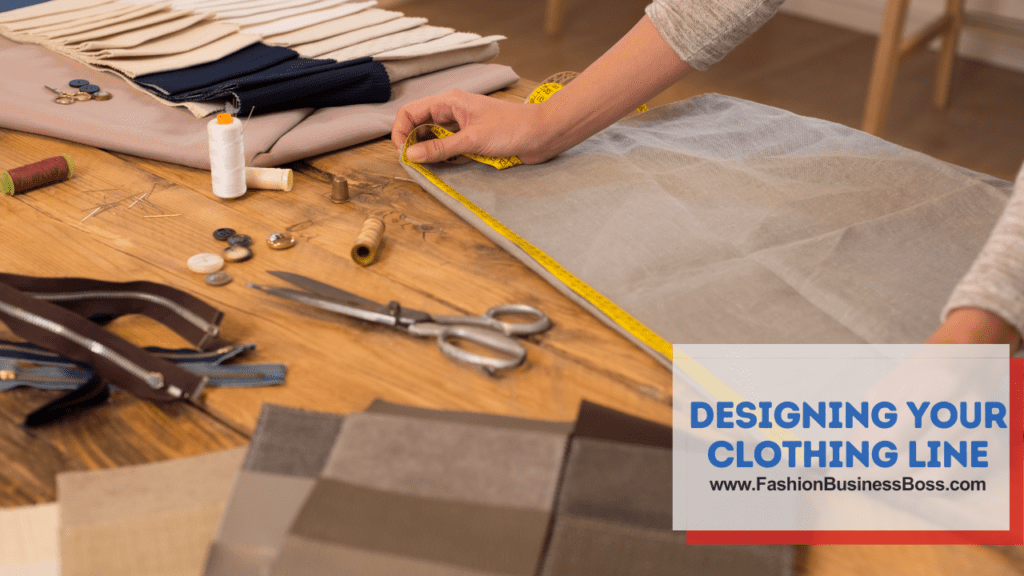Are you passionate about fashion and have an eye for design? Have you always dreamed of launching your own clothing line but don’t know where to start? Turning fabric into a fortune through your own fashion brand is an exciting and fulfilling journey, but it requires careful planning, creativity, and business acumen.
To create a clothing line, understand the fashion landscape, define your USP, research your target audience, craft a captivating brand identity, focus on diverse design, source quality materials, prototype, build an online presence, and prepare for a grand launch.
In this article, we will take you step-by-step through the process of starting your dream clothing line and turning it into a great venture.
Understanding the Fashion Landscape

Firstly, research is paramount. Familiarize yourself with current fashion trends, consumer preferences, and market demands. This knowledge will guide your decisions and help you create products that resonate with your target audience.
Next, establish a clear brand identity. Define your clothing line’s unique style, values, and mission. This identity will set you apart in a competitive market and attract like-minded customers.
Once your vision is in place, focus on practicalities. Register your business, obtain necessary permits, and set up your finances. Budgeting wisely ensures sustainable growth.
Quality is non-negotiable. Source high-quality materials and partner with reliable manufacturers. Maintaining consistent product quality builds trust with customers.
Lastly, develop a solid marketing strategy. Utilize social media, e-commerce platforms, and collaborations to reach your audience effectively.
Read more about: From Hobby to Hustle: How to Start Your Home-Based Clothing Brand
Defining Your Unique Selling Proposition (USP)
Establishing your clothing line begins with a critical step: defining your Unique Selling Proposition (USP). A USP is what makes your brand distinct and appealing to potential customers. Let’s delve into this important aspect.
Firstly, conduct market research to understand your competition and target audience. Identify gaps or opportunities within the fashion landscape that your clothing line can fill. This research provides the foundation for your USP.
Next, pinpoint what sets your brand apart. It could be your design aesthetic, use of sustainable materials, affordable pricing, or a combination of factors. Your USP should resonate with your intended customer base.
Once you’ve determined your USP, weave it into every aspect of your clothing line. From your branding and product design to marketing and customer service, your unique selling proposition should be evident.
Consistency is key. Your USP should remain a constant thread throughout your business journey. Communicate it clearly to your audience through your website, social media, and other marketing channels.
Market Research and Target Audience
Initiating your clothing line involves essential steps, and one of the most crucial is conducting thorough market research and identifying your target audience.
To begin, delve into the fashion landscape. Investigate the current trends, styles, and consumer preferences. This knowledge will serve as your compass when making decisions for your clothing line.
Next, focus on your potential customers. Define your target audience in simple terms. Consider factors like age, gender, location, and lifestyle. Understand their needs and desires, which will guide your product offerings.
Competitor analysis is key. Examine other clothing brands catering to your target audience. Identify gaps or areas where you can provide something unique or better.
Moreover, keep an eye on market size and growth potential. Ensure there is enough demand for your products.
Once you’ve gathered this data, create a detailed profile of your ideal customer. This persona will help you tailor your designs, marketing, and branding to resonate with your target audience.
Creating a Captivating Brand Identity
Establishing your clothing line necessitates the creation of a captivating brand identity. This identity is what distinguishes your brand and makes it appealing to potential customers. Let’s delve into the essential steps involved in this process.
First and foremost, consider your brand’s core values and mission. What do you want your clothing line to represent? Your brand’s identity should align with these principles.
Designing a memorable logo and choosing a cohesive color palette are vital elements of your brand identity. These visual elements should reflect your brand’s personality and resonate with your target audience.
Moreover, crafting a compelling brand story can help establish an emotional connection with customers. Share the journey, inspirations, and motivations behind your clothing line.
Consistency is key. Ensure that your brand identity is evident across all touchpoints, including your website, social media profiles, packaging, and marketing materials.
Lastly, engage with your audience authentically. Listen to their feedback, respond to inquiries, and build a genuine relationship with your customers.
Designing Your Clothing Line

Designing your own clothing line is a multifaceted process that involves several crucial steps. It all begins with conceptualizing your ideas, where you should sketch or describe your clothing designs, considering style, colors, and overall aesthetics. These ideas will form the foundation of your clothing line.
Once your concepts are clear, the next step is to create physical prototypes or samples. You can either do this yourself if you have sewing skills or collaborate with a skilled pattern maker or designer who can bring your designs to life.
Selecting the right materials is equally important. Choose fabrics and materials that align with your design vision and budget, and research suppliers and manufacturers who can provide what you need.
Costing and pricing are essential considerations. Calculate the cost of production, encompassing materials, labor, and overhead. Establish a pricing strategy that covers your costs while offering a competitive yet effective price point.
Moving into production, work closely with manufacturers or production teams to bring your designs to fruition, ensuring quality control and consistency in every piece.
Don’t forget to invest in branding and labeling. Design labels and tags that represent your brand and attach them to your clothing items to establish your brand identity.
Read more about: From Concept to Catwalk: Starting a Clothing Line from Scratch
Sourcing Quality Materials and Manufacturers
Sourcing quality materials and collaborating with reliable manufacturers are essential steps in the journey to start your clothing line. First and foremost, you must carefully select the materials for your clothing designs, taking into consideration factors like appearance, texture, and durability. Balancing quality with affordability is key, as you want materials that align with your vision while staying within your budget. Research various suppliers and wholesalers to find the right materials for your needs.
Next, delve into supplier research. It’s crucial to thoroughly investigate potential material suppliers. Assess their reputation, pricing, and ability to consistently provide the materials you require in the desired quantity and quality. Establish clear communication channels with your chosen suppliers to ensure a smooth and dependable flow of materials.
Once you have your materials in place, it’s time to collaborate with manufacturers who specialize in the type of clothing you intend to produce. Look for manufacturers with a proven track record in producing the kind of garments you’re planning, whether it’s casual wear, sportswear, or formal attire. Evaluate their production capabilities, quality control measures, and ethical practices.
Prototyping and Testing
Prototyping and testing are integral phases in launching your clothing line. Once you’ve conceptualized your designs and acquired materials, the prototyping phase begins. Prototypes are initial versions of your garments that serve as tangible representations of your designs. Depending on your expertise, you can create these prototypes yourself or collaborate with a skilled pattern maker or designer to bring your visions to life. The aim is to see how your designs translate into actual clothing and make necessary adjustments.
Following the prototyping phase, the testing stage is crucial. Engage a small, trusted group of individuals, which can include friends, family, or those with a keen fashion sense. Encourage them to wear the prototypes and provide candid feedback on factors like fit, comfort, and overall appeal. Their insights are invaluable in identifying any issues or areas that require improvement.
Building an Online Presence
Starting your own clothing line can be an attainable goal with a well-structured approach. First and foremost, begin by thoroughly researching the fashion industry. Understand the trends, target audience, and your niche within the market. This knowledge will serve as a solid foundation for your venture.
Next, create a clear business plan. Outline your budget, including expenses for materials, production, and marketing. Keep your financial goals realistic and within reach.
Now, focus on product development. Design clothing that resonates with your target customers. Ensure the quality meets or exceeds expectations. Consider working with reliable manufacturers or suppliers.
Building an online presence is crucial. Create a user-friendly website to showcase your clothing line. Invest in professional product photography to entice potential customers. Utilize social media platforms to engage with your audience and share your brand story.
Marketing is key. Employ strategies such as SEO, email marketing, and collaborations with influencers to increase brand visibility. Consistency in your efforts will help your clothing line gain traction.
The Grand Launch

Embarking on the journey to establish your clothing line is a promising endeavor. To set the stage for your grand launch, follow these essential steps.
Begin by immersing yourself in thorough market research. Understand the fashion landscape, identify trends, and pinpoint your target audience. This knowledge will be the cornerstone of your clothing line.
With a clear understanding of your market, it’s time to draft a comprehensive business plan. Calculate your budget meticulously, considering expenses for materials, production, and marketing. Keep your financial goals attainable.
The heart of your clothing line lies in product development. Design apparel that resonates with your chosen audience. Prioritize quality to meet or exceed customer expectations. Collaborate with reliable manufacturers or suppliers to bring your vision to life.
Building a robust online presence is paramount. Create a user-friendly website to showcase your clothing line. Invest in professional product photography to entice potential customers. Utilize social media platforms to engage with your audience and convey your brand’s narrative.
Effective marketing strategies are essential. Implement tactics like SEO, email marketing, and collaborations with influencers to enhance brand visibility. Persistence in your efforts will gradually establish your clothing line’s presence.
Read more about: From Closet to Cash: How to Start Selling Clothes and Flourish
Conclusion
Launching your dream clothing line is an exhilarating journey that requires meticulous planning, creativity, and resilience. With a well-defined brand identity, high-quality designs, and effective marketing strategies, you can outrank other websites and turn fabric into fortune.
Frequently Asked Questions

What role does branding play in the growth of a clothing line?
Branding plays a pivotal role in the fashion industry as it defines the identity and uniqueness of your clothing line. Your brand identity, encompassing elements like logo, color palette, and brand voice, reflects your Unique Selling Proposition (USP) and resonates with your target audience. It goes beyond aesthetics, forging a deep connection with customers and fostering brand loyalty. Crafting a strong brand identity sets the tone for your clothing line’s entire journey and positions it as an authentic and recognizable presence in the competitive market.
How can I ensure the quality of my clothing line?
Ensuring the quality of your clothing line is crucial for long-term growth. It relies heavily on two factors – the materials used and the expertise of manufacturers. Building relationships with reliable suppliers who share your commitment to quality ensures you have access to premium fabrics and materials. Collaborating with skilled manufacturers who value craftsmanship and precision translates to garments that are exquisitely designed and finished. Moreover, embracing ethical and sustainable practices throughout the production process not only enhances the appeal of your clothing line but also aligns it with the growing demand for conscious consumerism.
What steps to take to make my clothing line stand out in the digital landscape?
To stand out in the digital age, leveraging effective SEO strategies and maintaining a strong online presence is essential. By using keyword-rich titles and meta descriptions, your web pages are more likely to rank higher in search engine results, driving organic traffic. Generating high-quality, relevant content through blogs and articles establishes your brand as an authoritative voice in the fashion industry, engaging your audience and fostering trust. Furthermore, optimizing your website for mobile devices enhances user experience, encouraging seamless browsing and driving higher engagement. Embracing social media platforms to showcase your designs and interact with your audience allows you to build a loyal following and increase brand visibility within the digital realm.
To learn more about starting your own clothing business, check out my startup documents here.
The information provided by FashionBusinessBoss.com (“The Site”) is for general informational purposes only. All information on the Site is provided in good faith, however, we make no representation or warranty of any kind, express or implied, regarding the accuracy, adequacy, validity, reliability, availability or completeness of any information on the Site. Under no circumstance shall we have any liability to you for any loss or damage of any kind incurred as a result of the use of the Site or Reliance on any information provided on the Site. Your use of the Site and your reliance on any information on the Site is solely at your own risk. This blog post is for educational purposes only and does not constitute legal advice. Please consult a legal expert to address your specific needs. Terms and Conditions. (https://fashionbusinessboss.com/terms-and-conditions/)

Meet Shawn Chun: Entrepreneur and Fashion Business Fan.
I’m a happy individual who happens to be an entrepreneur. I have owned several types of businesses in my life from a coffee shop to an import and export business to an online review business plus a few more and now I create online resources for those interested in starting new ventures. It’s demanding work but I love it. I do it for those passionate about their business and their goals. That’s why when I meet a designer or boutique owner at a craft fair, farmers market, retail location or anywhere else I see myself. I know how hard the struggle is to retain clients, find good employees and keep the business growing all while trying to stay competitive.
That’s why I created Fashion Business Boss: I want to help fashion business owners like you build a thriving business that brings you endless joy and supports your ideal lifestyle.

